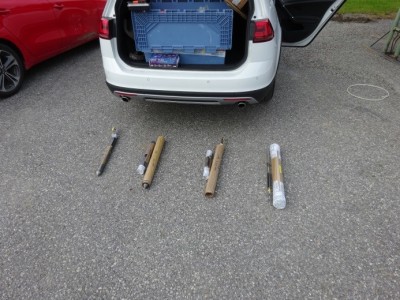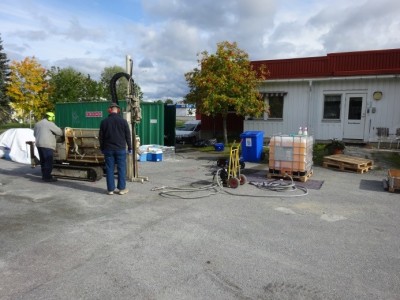
One of our students Markus Reischer could join a field investigation in Långsele – Sweden in week 37. This site is contaminated with chlorinated solvents and is investigated by Niras Sweden supported by Niras Denmark for a few years. The geology is set up by artificial deposit on top, followed by sandy sediments down to 6 m and below follows bedrock. The water table is around 3 m below surface. This project gave him the unique opportunity to participate in a professional project and to learn something about field investigation and injection. Furthermore, he could use this site for his own research as he could conduct an experiment there. The overall purpose of this field campaign was to install some wells, take some soil and water samples and do some logging with the Geoprobe to improve the understanding of this site. Furthermore several remediation options were tested. This included the gravity driven injection of dechlorinating bacteria (KB-1) via a well for enhanced biodegradation, vaccum testing for a later soil vapour extraction and direct push injection with the Geoprobe. As Markus is looking into new investigation and monitoring techniques, he could test there a new probe (OIP – Optical image Profiler) from Geprobe for detection of fluorescence. Fabian de Weirdt from Geoprobe Belgium introduced this new probe to the technicians and Markus at the site. The probe was develop for the detection of hydrocarbons originally. At this site the probes capabilities for the detection of Eosin was tested, which is a common fluorescent tracer for hydrogeological studies. The test was conducted as dual-tracer-test. Eosin was injected together with a highly conductive Dipotassiumphosphate solution. Eosin could be injected and detected successfully.







by
Markus Reischer
NIRAS A/S


Hi Markus,
Nice summary of your work with the OIP to test the detection of Eosin as a tracer. It is also worth noting that the EC response on the log you have shown here also appears to clearly track the dipotassium phosphate you injected in this low EC formation. So you get two independent methods to confirm the distribution of the injectate in the formation from 1 logging tool.
LikeLike